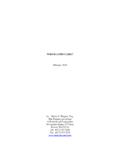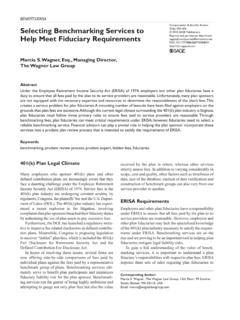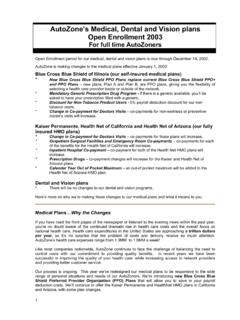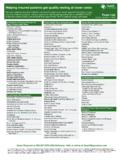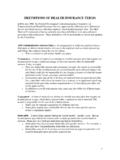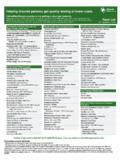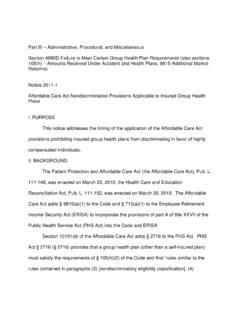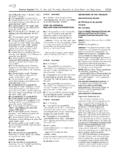Transcription of PROPERLY DOCUMENTING WELFARE PLANS - …
1 PROPERLY DOCUMENTING WELFARE PLANS By:Marcia S. Wagner, Wagner Law Group99 Summer Street, 13th FloorBoston, MA 02110 Telephone: (617) 357-5200 Facsimile: (617) 357-5250E-Mail: DOCUMENTING WELFARE PlansSince the passage of the Employee Retirement Income Security Act of 1974 ( ERISA ), most of the attention has been focused on compliance issues related to retirement PLANS . Lately, the Department of Labor ( DOL ) and the Internal Revenue Service ( IRS ) have been paying an increasing amount of attention to WELFARE PLANS . Employers, therefore, should take a close look at their WELFARE programs to make sure they are being administered in compliance with ERISA and the Internal Revenue Code.
2 Employers should pay particular attention to their WELFARE plan documents and summary plan plan DocumentsAll ERISA-covered PLANS including WELFARE PLANS must be administered in accordance with a written plan ERISA requires a WELFARE plan document to contain the following provisions: Named fiduciaries. The document must name one or more fiduciaries that have the authority to control and manage the operation and administration of the Allocation of The plan must include a procedure for allocating responsibilities for plan administration and operation. Funding PLANS that are completely unfunded ( , benefits are paid solely from the employer s general assets) are not required to have a funding Benefit The plan must state the basis on which benefits are paid to and from the plan .
3 Claims The plan must have a specific procedure for processing benefit claims and appeals that complies with DOL regulations. Amendment A provision allowing the employer to amend the plan frequently is not included in an insurance contract. Distribution of assets on plan Many insured PLANS do not address this requirement because many assume WELFARE PLANS do not have plan assets. Any WELFARE plan that accepts participant contributions has plan assets. Portability, special enrollment and The plan must describe certificates of coverage, special enrollment rights and nondiscrimination rules. Currently, the DOL is applying considerable attention to proper documentation and administration of these rules.
4 1 ERISA ERISA 402(a)(1).3 ERISA 402(b)(2).4 ERISA 402(b)(1).5 DOL Advisory Opinion 78-108A (Mar. 31, 1978).6 ERISA 402(b)(4).7 ERISA ERISA 402(b)(3).9 ERISA 402(d)(2).10 ERISA 701 to Privacy of health Group health PLANS must contain plan language protecting the medical privacy of plan participants and beneficiaries. Qualified medical child support Documents must specify the procedures for processing qualified medical child support following language is not specifically required to be in the plan under ERISA, but is strongly recommended for WELFARE plan documents: COBRA continuation of group health coverage. While this is not specifically required in the plan document, it is required in the summary plan description ( SPD ), and it is advisable that information in the SPD should also be in the plan document.
5 Benefits during military leave. While this is not specifically required in the plan document, it is required in the summary plan description ( SPD ), and it is advisable that information in the SPD should also be in the plan document. Minimum hospital stays after childbirth. While this is not specifically required in the plan document, it is required in the summary plan description ( SPD ), and it is advisable that information in the SPD should also be in the plan document. Minimum requirements for women s health. The plan must comply with requirements for coverage of reconstructive surgery and other complications associated with a mastectomy. Subrogation/reimbursement. In the event that a participant or beneficiary receives payment from a third party for a benefit paid by the plan , then the plan may require the participant or beneficiary to reimburse the plan for such payment.
6 While ERISA clearly defines key provisions that must be in a plan document, it does not specify what constitutes a plan document. As a result, there has been a significant amount of confusion identifying written plan documents for ERISA-covered WELFARE PLANS . Many employers assume that insurance contracts for fully insured products are written plan documents. Insurance companies, however, draft the contracts to comply with state insurance laws, and as a result the contracts often do not contain required and/or recommended provisions that protect the plan , the employer and the fiduciaries. For example, an insurance contract may state that the insurance company has the right to amend or terminate the contract, but may not state that the employer has that right.
7 As a result, a court may conclude that an employer may not be able to amend or terminate its WELFARE plan until it (i) adopts a formal written plan containing procedures for amending or terminating the plan , and (ii) identifies in the plan those individuals who have the authority to carry out such actions. Insurance contracts may make up part of the plan document, but they are rarely complete documents for ERISA purposes, often excluding such basic requirements as required claims procedures or providing a methodology which does not comply with relying on insurance contracts to satisfy the written plan requirements should also keep in mind that such contracts often are not updated timely to comply with 11 45 CFR (f).
8 12 ERISA 609(a).2legislative changes. As a result, such contracts may not only be incomplete for ERISA purposes, but also out of address this problem, many employers, adopt wrap or umbrella plan documents that coordinate with already existing plan documents ( , insurance contracts) to create a single plan document. Wrap plan documents create a single plan document by incorporating (or wrapping) other plan document(s) into the wrap plan which contains required as well as recommended language that may not be in the underlying document(s). Therefore, a formal WELFARE plan document that complies with ERISA should consist of a wrap plan and those documents incorporated into the wrap plan .
9 Adoption of a wrap plan is appropriate even in those situations when an employer maintains a benefit under only one similar to those with insurance contracts also exist when the plan is administered through a contract with a third party administrator ( TPA ). Reliance on a contract ( , a self-insured agreement or servicing contract) could be problematic. While the agreement may describe the plan in detail, it is written to outline the responsibilities of the employer and the TPA. As a result, such documentation is not written as plan documents and often fails to comply with ERISA. For example, servicing contracts often do not include language describing procedures for qualified medical child support orders in accordance with DOL regulations.
10 The servicing agreement, by itself, would not meet the requirements for a written plan document as described under ERISA. Also, contracts rarely describe claims language that complies with DOL regulations because TPAs do not want to be considered plan fiduciaries. Claims language should appear in the plan language not only for clarity and consistency, but also to make sure that the TPA understands that the plan fiduciaries will hold the TPA to those standards set by the DOL. Again, employers should consider using a wrap plan document if they have only one contract or servicing agreement in place or if they have several contracts and/or agreements in place. To ease administration, an employer may wrap more than one kind of WELFARE plan into a single plan .

